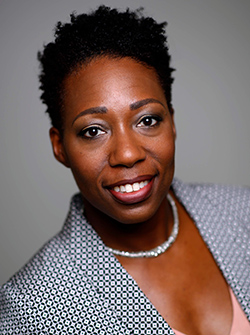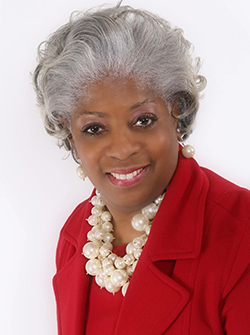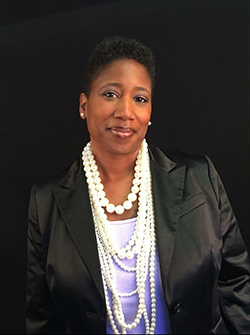Applying an Equity Lens to Safe Sleep and Breastfeeding Efforts
Black families are twice as likely as white families to have their baby die in the first year of life. In Ohio and Wisconsin, they are three times as likely. These statistics are more than numbers; they represent real families who suffer unimaginable loss—loss that stems from the persistent effects of systemic racism on the health of Black families.
Comprehensive improvement requires elevating Black mothers, birthing people, and families as leaders in driving change at the community, hospital, and system level. That’s why the NICHQ-led National Action Partnership to Promote Safe Sleep Improvement and Innovation Network (NAPPSS-IIN) relies on a diverse team of faculty experts. NAPPSS-IIN is a Health Resources and Services Administration Maternal and Child Health Bureau-funded initiative seeking to make infant safe sleep and breastfeeding the national norm. The faculty experts bring a vital equity lens to hospital and community-based efforts to eliminate disparities in safe infant sleep and breastfeeding by helping them develop culturally competent approaches and resources.
About the Contributors
Michelle Edison, MPH, MS, is the Pathways HUB Coordinator for Mahoning County Public Health in Northeast Ohio. Edison works in a county that has some of the highest disparities in the state of Ohio, and spends every day identifying and addressing risk factors to improve health outcomes.
|
To help spread their expertise and perspectives to a broader audience, we sat down with three NAPPSS-IIN faculty experts: Michelle Edison, MPH, MS; Wanda Montgomery, MS; and Misty Wilder. Below, they share their recommendations for how health professionals and improvement initiatives can better support the health and well-being of Black families.
Begin conversations about safe sleep and breastfeeding early
Starting conversations about safe sleep and breastfeeding/chestfeeding in the first trimester gives families more time to ask questions and make necessary preparations, such as getting a crib and learning about breastfeeding. It also gives health professionals time to respond to concerns and connect families with resources. This is important for all families, but especially for populations who may face unique social or cultural barriers.
“These barriers take time to process and can’t be overcome in a single conversation,” says Wilder. “Especially if we’re left scrambling to have that conversation during delivery when there is so much going on. It takes time to build a relationship so families feel comfortable asking questions and sharing concerns; and then it takes time to connect them with the services that can support them. Handing them a packet about safe sleep at delivery isn’t enough—providers need to start these conversations early.”
Don’t make assumptions about families; instead, give them an opportunity to share their perspectives and circumstances
Too often, says Wilder, health professionals make assumptions about families based on their race, ethnicity, or socioeconomic status. And intentionally or not, this results in alienating advice.
“Telling a mother, ‘you need prenatal care because you are high risk;’ assuming a family can’t afford a crib because of their skin tone or their insurance; and if a family is low-income, assuming that they’re most interested in the money breastfeeding saves rather than the benefits for the child—this language is stigmatizing,” she explains.
Rather than begin safe sleep and breastfeeding/chestfeeding conversations with instructions or assumptions about what families know or think, health professionals should instead start by asking them to share their goals and opinions. This gives families an opportunity to describe their motivations and reveal any potential barriers, such as unstable housing or concerns about childcare and going back to work. In response, health professionals can personalize their advice for that individual family, meeting them where they are rather than imposing guidelines and assumptions with little regard for their individual circumstance.
“Asking our clients to share their experiences is really important,” says Edison. “It’s all about establishing relationships and building trust, and that depends on giving them a voice.”
Community health workers can drive change
“Safe sleep inequities are so pervasive and it’s such a crisis, we can’t just focus on one place for education,” says Edison. “Health care professionals need to rely more on public health and community partners to support the community needs.”
As a coordinator for the Mahoning Valley Pathways HUB, Edison has seen the success of these partnerships firsthand. The HUB connects at-risk families with trained community health workers who share resources, education and support. Since community health workers are usually from the communities they serve, they become trusted advocates who can work with families to overcome potential barriers.
Montgomery has seen similar successes with the Children’s Hospital of Wisconsin’s community health navigators who work directly with families to share safe sleep education and connect them with resources. The hospital has also identified specific neighborhoods with higher health disparities and partnered with community organizations in those neighborhoods to help ensure there are health navigators and care options closer to home.
Extend education and outreach to all potential caregivers
“Many Black women were raised with the belief that the whole family is responsible for taking care of the child, so more often than not, the child is going to stay with the grandmother, aunt, or another family member for part of the day,” explains Wilder. “This means if I’m a new mom and my family doesn’t have the same education about safe sleep and breastfeeding as me, I’m fighting an uphill battle.”
Efforts that reach out to all family members, and especially aunts and grandmothers, can help spread recommendations to all potential caregivers. In doing so, health professionals can more effectively address misconceptions about safe sleep and potential cultural stigmas around breastfeeding. Since talking to everyone in the family isn’t always possible, spend time discussing potential family members’ reactions with the mother or birthing person, so they feel prepared to explain why they are choosing to breastfeed/chestfeed and practice safe sleep.
When having these conversations, Montgomery recommends taking a strength-based approach that respects and builds off the family’s values. “There are a lot of things we used to do years ago that we’re not going to do today. Things change, but we need to help families change with them without making them feel like they did something wrong.”
Host community outreach and training events
Community educational events can help health professionals and community partners reach more families and reaffirm the benefits of safe sleep and breastfeeding/chestfeeding, says Montgomery. Train-the-trainer events are especially effective because they can help spread the messages beyond the one event. Similarly, engaging partners outside of health care and public health, such as fraternities and sororities and the faith community, can help ensure that consistent messages touch every part of the community. When planning events, remember to make reasonable accommodations for families. Providing childcare and a meal can help families who simply don’t have time to find a place to leave their child, attend an event and then go home and make dinner.
Along with raising awareness, community events also create space for families to talk to one another and discuss cultural concerns, says Wilder.
“Once, we hosted an event where we talked about how our grandmothers, the gatekeepers of the community, viewed breastfeeding. People shared the stigmas they’d heard—how the practice of wet nursing, where an enslaved Black woman nursed a white baby, played a role in how older generations view breastfeeding; how being able to buy formula meant you didn’t have to breastfeed. Making space for these conversations is important because it helps us understand how our community views something, identify what’s contributed to those views, and debunk myths.”
Purposefully seek diversity in hiring practices
Trust is necessary for safe sleep and breastfeeding/chestfeeding conversations. But it’s hard for families of color to trust a facility when they don’t see enough people who look like them, says Montgomery. “Especially for families who have experienced bias or racism. If the majority of the population you serve is of color, your staff needs to reflect that.”
Altering hiring practices and policies to increase diversity is an important step towards achieving equity. Black health professionals can talk to Black families with real empathy about the barriers they’ve encountered and share their own personal experiences, building a relationship that encourages honest and open conversations about safe sleep and breastfeeding.
Recognize that disparities stem from a structural problem
Improving hiring practices is just one step in addressing what is ultimately a systemic problem. Hospitals, health care systems, state health departments, and community leaders need to re-examine all policies and procedures with an equity lens, or the system will continue to keep communities of color from reaching their health potential, explains Edison. The first step, she says, is confronting the pervasiveness of bias and racism.
“We create these barriers unconsciously, so we can’t see them,” says Edison. “And the boots on the ground can only do so much when confronted with these long-term embedded barriers. That’s why, now, we need to take a step back, uncover the entrenched practices that contribute to these disparities, and then make that information accessible to everyone. By raising awareness about the effects of bias and racism, we can begin prioritizing health equity trainings, changing policies, and improving the system.”
Interested in hearing from more NAPPSS-IIN faculty experts? Here, read an article about the persistent effects of historic trauma on indigenous people.


 Wanda Montgomery, MS, has spent nearly three decades working in early care and education. As the Director of Community Partnership at the Children’s Hospital of Wisconsin, Montgomery builds partnerships between health, education and community-based organizations so that children and families in Wisconsin can receive wrap-around support and services.
Wanda Montgomery, MS, has spent nearly three decades working in early care and education. As the Director of Community Partnership at the Children’s Hospital of Wisconsin, Montgomery builds partnerships between health, education and community-based organizations so that children and families in Wisconsin can receive wrap-around support and services. Misty Wilder has been working to eliminate disparities in infant mortality in Texas for twelve years. She currently serves as the Director of Healthy Start for the University of North Texas Health Center and is passionate about working to ensure Black families have what they need to move from surviving to thriving in their communities.
Misty Wilder has been working to eliminate disparities in infant mortality in Texas for twelve years. She currently serves as the Director of Healthy Start for the University of North Texas Health Center and is passionate about working to ensure Black families have what they need to move from surviving to thriving in their communities.